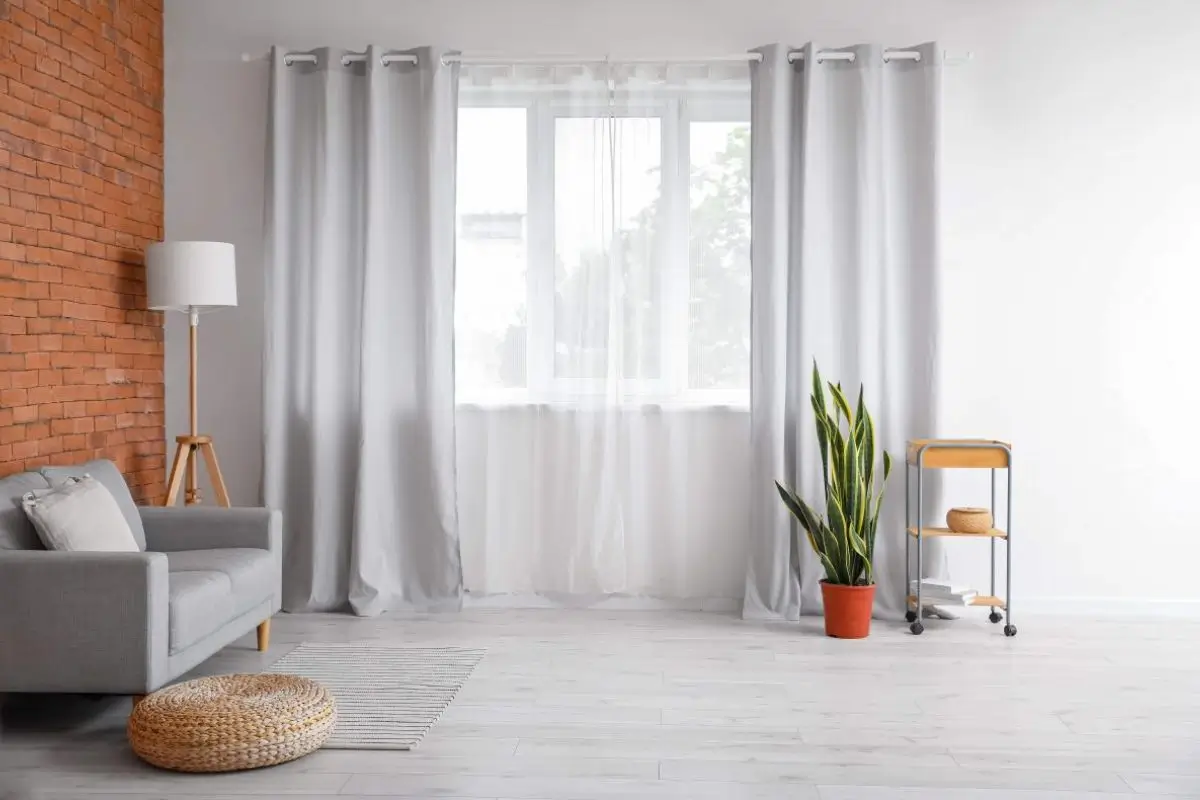Curtains are often chosen for their aesthetic appeal, but their practical benefits are frequently overlooked. One significant advantage is their ability to improve indoor air quality. This blog will explore how curtains play a crucial role in filtering air, blocking outdoor pollutants, regulating humidity, and much more. These factors contribute to a healthier living environment, making curtains not just decorative but also functional.
Transform Your Space: How Curtains Filter the Air You Breathe
Certain curtain fabrics act as natural air filters by trapping dust, pollen, and other airborne particles. Heavy materials like velvet or dense weaves can capture more particles, making them especially effective in high-traffic or dusty areas. Curtains create a physical barrier between the interior space and airborne pollutants, preventing contaminants from circulating freely. Regularly cleaned, curtains help maintain cleaner indoor air by trapping allergens that would otherwise be inhaled. This simple addition to a room can offer significant health benefits, especially for individuals with allergies or respiratory issues. Choosing curtains with dense fabric ensures that your home’s air quality is improved while simultaneously enhancing the room’s decor. To maximize their air-filtering ability, regular vacuuming and occasional washing are crucial to prevent build-up and maintain their efficacy in trapping pollutants.
Your First Line of Defense: Curtains as Barriers to Outdoor Pollutants
Curtains can serve as a protective layer that blocks outdoor pollutants such as exhaust fumes, smoke, and dust from entering through open windows. This benefit is especially valuable in urban areas with high pollution levels. Fabrics like blackout curtains are particularly effective at forming a barrier due to their thickness and ability to fit snugly against windows. By preventing these external pollutants from entering the living space, curtains contribute to a cleaner indoor environment. This function reduces the amount of airborne particles inside your home, lowering the risk of respiratory issues and improving overall air quality. Selecting curtains made of tightly woven materials can amplify this effect, ensuring that fewer pollutants slip through. This benefit is not only valuable for homes but also for office spaces where air quality impacts productivity and well-being.
Combat Mold and Mildew: The Role of Curtains in Moisture Control
Curtains can help regulate indoor moisture, which is crucial for maintaining air quality and preventing mold growth. Excessive humidity creates an environment where mold and mildew can thrive, releasing spores that degrade air quality and cause health issues. Fabrics that are moisture-resistant or designed for high-humidity environments, such as synthetic blends or treated natural fibers, are particularly effective in combating this. Additionally, curtains can be used to shade windows and minimize temperature fluctuations that contribute to condensation buildup. By preventing excess moisture from accumulating on window surfaces, curtains reduce the risk of mold growth. Regularly washing and drying your curtains can further inhibit mold development, ensuring they continue to enhance your indoor air quality. This preventive measure contributes to a healthier home environment, especially in regions with high humidity.
Freshen Up: How Curtains Absorb and Neutralize Household Odors
Curtains can act as passive air fresheners, absorbing and neutralizing unpleasant odors within a home. Fabrics like cotton or those treated with natural odor-absorbing substances can trap smells from cooking, smoke, or pets. This ability helps maintain fresher indoor air and prevents lingering odors that can impact overall air quality. To maintain their effectiveness, curtains should be aired out regularly or sprayed with fabric-safe deodorizers. This can be particularly beneficial for homes with open kitchen designs or high-traffic areas where odors tend to accumulate. While not a complete replacement for air purifiers or proper ventilation, curtains add an additional layer of odor control. Choosing curtains made of breathable, natural fabrics can enhance this function, ensuring a fresher atmosphere in your living space without the need for chemical sprays or artificial air fresheners.
Allergy Relief: How Curtains Reduce Indoor Allergens
Curtains can significantly reduce the number of allergens circulating indoors. Dust mites, pet dander, and pollen are common allergens that can affect health and comfort. By acting as a barrier and trapping these particles, curtains contribute to cleaner air quality. To maximize this benefit, opt for machine-washable curtains that can be cleaned regularly. This prevents allergens from accumulating and spreading when disturbed by air movement. For individuals prone to allergies or asthma, hypoallergenic fabrics such as tightly woven cotton or synthetic blends are excellent choices. Regular cleaning routines, including vacuuming the curtain fabric and washing at high temperatures, ensure that allergens do not build up. This practice enhances your home’s air quality and contributes to a healthier indoor environment, reducing allergy symptoms and improving overall comfort.
Stay Comfortable: The Impact of Thermal Insulating Curtains on Air Quality
Curtains play an important role in regulating indoor temperature, which indirectly impacts air quality. Heavy, insulated curtains help maintain a consistent room temperature by reducing heat loss in the winter and blocking heat gain in the summer. This function reduces the reliance on heating and cooling systems, which can circulate dust and other allergens when overused. By lowering the frequency and intensity of HVAC use, curtains help prevent the redistribution of airborne particles, contributing to cleaner indoor air. Additionally, well-regulated temperatures minimize the risk of moisture buildup, which can lead to mold and negatively affect air quality. Energy-efficient curtains with thermal backing provide both temperature control and enhanced indoor air quality. This dual function makes them an effective addition to homes, promoting both environmental sustainability and health.
Go Green: Choosing Eco-Friendly Curtains for a Healthier Home
Selecting eco-friendly and non-toxic curtains can greatly contribute to healthier indoor air. Many synthetic curtains are treated with chemicals that off-gas volatile organic compounds (VOCs), impacting air quality. Opting for natural fabrics such as organic cotton, linen, or bamboo ensures that your home remains free from these harmful emissions. Curtains certified by environmental standards, such as OEKO-TEX or GOTS, are guaranteed to be free from toxic substances. Using non-toxic, natural dyes can further reduce the risk of chemical exposure. By choosing eco-friendly options, you not only contribute to sustainable living but also protect your household from the dangers of indoor air pollution. This approach is especially important for homes with young children or individuals sensitive to chemicals.
Keep It Clean: Best Maintenance Practices for Air-Improving Curtains
Maintaining curtains properly is essential to ensure they continue to improve air quality. Regular cleaning prevents curtains from becoming a source of dust and allergens. Vacuum curtains weekly with an upholstery attachment to remove surface dust and schedule full washes as recommended by the manufacturer. If machine-washing, use a gentle cycle and appropriate detergents to avoid damaging the fabric. For heavy curtains that can’t be machine-washed, consider professional cleaning. Exposure to sunlight can help air out curtains and eliminate bacteria naturally. Rotating and airing out curtains seasonally is another useful practice. Maintaining clean, well-kept curtains ensures that they continue to filter air and block pollutants effectively. Consistent upkeep enhances the longevity of the fabric and maximizes their contribution to indoor air quality.
Balance the Air: How Curtains Help Control Indoor Humidity
Curtains help control indoor humidity, which is vital for maintaining air quality. When drawn during cooler times of the day, curtains can trap cool air and prevent excessive humidity from seeping indoors. Conversely, opening curtains during low-humidity periods allows for better airflow and reduces moisture buildup. Choosing breathable fabrics such as cotton and linen can aid in regulating humidity levels. These materials allow air circulation while still providing a protective barrier against outside weather. By controlling humidity, curtains help prevent the growth of mold and mildew, which can degrade air quality. Properly managing indoor humidity levels contributes to a healthier home environment and reduces the need for additional dehumidifying devices.
Conclusion
Curtains offer more than just decorative value; they contribute significantly to indoor air quality. From filtering pollutants to regulating temperature and humidity, curtains have multiple health benefits. Choosing the right materials and maintaining them properly ensures a cleaner, healthier indoor environment. With strategic selection and care, curtains become an effective tool in promoting better air quality and overall well-being in your home.







